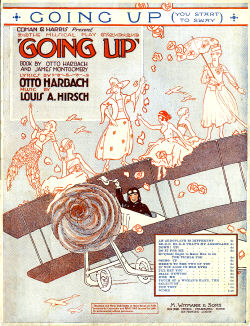Kurt Gänzl
The Encyclopedia of the Musical Theatre
3 September, 2014
James Montgomery’s 1910 play The Aviator was put to musical use seven years on by its author and the now practised manufacturer of musical comedy Otto Harbach, several of whose biggest successes to date (Three Twins, Madame Sherry, High Jinks) had been with adaptations.

Sheet music cover for “Going Up!”
The music was allotted to Louis Hirsch, composer of two recent Ziegfeld Follies since his well-timed incursion into London revue, but whose record with book musicals was less impressive. Going Up changed that when it premiered at the Liberty Theater, New York, on 25 December 1917.
The libretto concerned one Robert Street (Frank Craven), the author of a popular book on flying called Going Up. When challenged to a flying race by the jealous French aviator Jules Gaillard (Joseph Lertora), whose girlfriend, Grace Douglas (Edith Day), he has attracted, he finds himself in a spot, for Robert’s book is fiction and he has never handled an aeroplane. Grace, misunderstanding the situation, agrees to marry the winner of the challenge. Robert is given hurried flying lessons, and wins the contest, staying up in the sky longest simply because he is unable to land. When he does get down, he finds he is still a hero, and an affianced one. Frank Otto played Hopkinson (‘Hoppy’) Brown, Robert’s comical pal, whilst Marion Sunshine was Madeleine, Grace’s chum, with whom Hoppy, inevitably, paired off.
Hirsch’s songs included a delicious mixture of the lightest contemporary popular strains: the jaunty title-number led by the flying Frenchman, a dance speciality in which everyone was exhorted to do ‘The Tickle Toe’, Grace’s graceful piece about the effect of `The Touch of a Woman’s Hand’, Madeleine’s march-time creed that ‘I Want a Boy (who’s determined to do what I say)’ and, above all, the two girls’ delightful duo ‘If You Look in Her Eyes’.
Sam Harris and George M Cohan’s Broadway production of Going Up was a first-class success and remained 351 performances at the Liberty Theater before going on the road, but an even longer run awaited Joe Sacks’s London mounting, produced under the reign of Alfred Butt at the Gaiety Theatre with Evelyn Laye (Madeleine), Marjorie Gordon (Grace), Joseph Coyne (Robert), Austin Melford (Hoppy) and Henry de Bray (Gaillard) leading the cast, and Arthur Chesney in the rôle of Grace’s gambling-mad father. The show gave the Gaiety one of its greatest successes as wartime turned into celebration time, and it ran up 574 victory-year performances before going touring.
Australia, too, gave the show a strong welcome. Alfred Frith (Robert), Ethel Erskine (Grace), Cecil Bradley (Madeleine) and Jack Hooker (Gaillard) were featured in a very impressive 15-week run in Melbourne prior to an even more successful Sydney season of 17 weeks and 116 performances at the Criterion (23 August 1919), there was a return run in 1921, and for years half of urban Sydney was musically encouraging the other half to `do the tickle-toe’.
In spite of its great initial success, “Going Up” was subsequently forgotten, whilst less successful shows and songs by more fashionable and/or well-plugged songwriters got the attention.
But in 1976 it was revived in a revised version (which included the intake of other Hirsch songs, notably ‘I’ll Think of You’ from The Rainbow Girl) at the Goodspeed Opera House. Successful there, it did not survive a transfer to Broadway’s John Golden Theatre (19 September) where it played but 49 performances.
A 1923 film version featured Douglas McLean as Robert Street, Hallam Cooley as Hoppy, Marjorie Daw and Edna Murphy as the girls, and Mervyn Le Roy in a supporting rôle.
UK: Gaiety Theatre 22 May 1918; Australia: His Majesty’s Theatre, Melbourne 19 April 1919; Film: 1923
